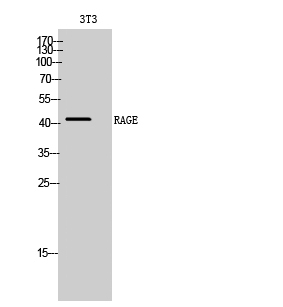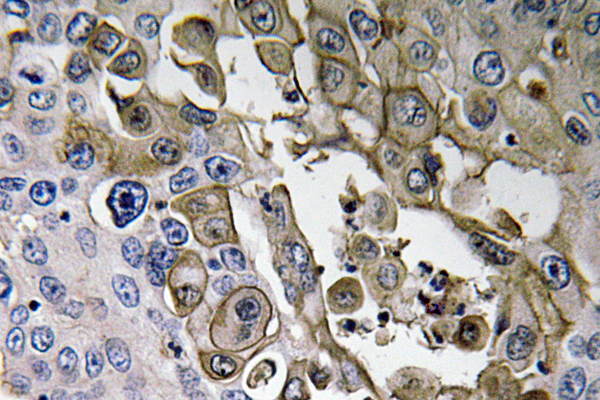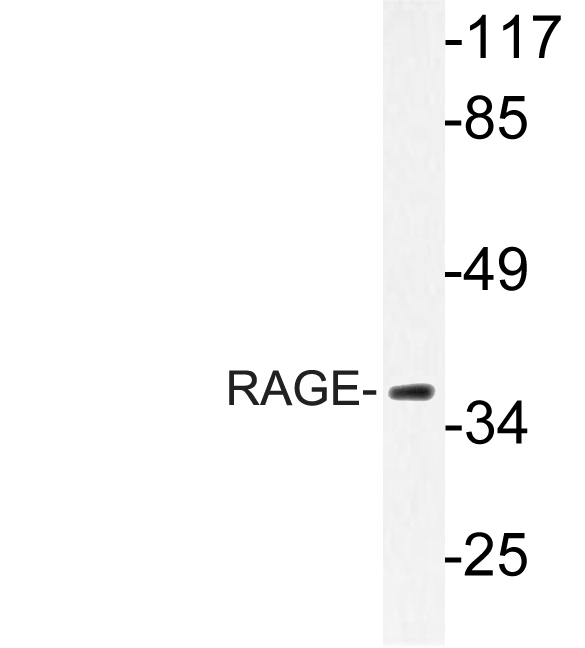RAGE Polyclonal Antibody
- Catalog No.:YT3993
- Applications:WB;IHC;IF;ELISA
- Reactivity:Human;Rat;Mouse;
- Target:
- RAGE
- Fields:
- >>Neutrophil extracellular trap formation;>>AGE-RAGE signaling pathway in diabetic complications;>>Alzheimer disease;>>Pathways of neurodegeneration - multiple diseases;>>Diabetic cardiomyopathy;>>Lipid and atherosclerosis
- Gene Name:
- AGER
- Protein Name:
- Advanced glycosylation end product-specific receptor
- Human Gene Id:
- 177
- Human Swiss Prot No:
- Q15109
- Mouse Swiss Prot No:
- Q62151
- Immunogen:
- The antiserum was produced against synthesized peptide derived from human RAGE. AA range:133-182
- Specificity:
- RAGE Polyclonal Antibody detects endogenous levels of RAGE protein.
- Formulation:
- Liquid in PBS containing 50% glycerol, 0.5% BSA and 0.02% sodium azide.
- Source:
- Polyclonal, Rabbit,IgG
- Dilution:
- WB 1:500 - 1:2000. IHC 1:100 - 1:300. ELISA: 1:20000.. IF 1:50-200
- Purification:
- The antibody was affinity-purified from rabbit antiserum by affinity-chromatography using epitope-specific immunogen.
- Concentration:
- 1 mg/ml
- Storage Stability:
- -15°C to -25°C/1 year(Do not lower than -25°C)
- Other Name:
- AGER;RAGE;Advanced glycosylation end product-specific receptor;Receptor for advanced glycosylation end products
- Observed Band(KD):
- 37kD
- Background:
- The advanced glycosylation end product (AGE) receptor encoded by this gene is a member of the immunoglobulin superfamily of cell surface receptors. It is a multiligand receptor, and besides AGE, interacts with other molecules implicated in homeostasis, development, and inflammation, and certain diseases, such as diabetes and Alzheimer's disease. Many alternatively spliced transcript variants encoding different isoforms, as well as non-protein-coding variants, have been described for this gene (PMID:18089847). [provided by RefSeq, May 2011],
- Function:
- function:Mediates interactions of advanced glycosylation end products (AGE). These are nonenzymatically glycosylated proteins which accumulate in vascular tissue in aging and at an accelerated rate in diabetes. Receptor for amyloid beta peptide.,similarity:Contains 1 Ig-like V-type (immunoglobulin-like) domain.,similarity:Contains 2 Ig-like C2-type (immunoglobulin-like) domains.,tissue specificity:Endothelial cells.,
- Subcellular Location:
- [Isoform 1]: Cell membrane; Single-pass type I membrane protein.; [Isoform 2]: Secreted.; [Isoform 10]: Cell membrane ; Single-pass type I membrane protein .
- Expression:
- Endothelial cells.
3-Arylcoumarin inhibits vascular calcification by inhibiting the generation of AGEs and anti-oxidative stress JOURNAL OF ENZYME INHIBITION AND MEDICINAL CHEMISTRY Yanling Mu WB Human
- June 19-2018
- WESTERN IMMUNOBLOTTING PROTOCOL
- June 19-2018
- IMMUNOHISTOCHEMISTRY-PARAFFIN PROTOCOL
- June 19-2018
- IMMUNOFLUORESCENCE PROTOCOL
- September 08-2020
- FLOW-CYTOMEYRT-PROTOCOL
- May 20-2022
- Cell-Based ELISA│解您多样本WB检测之困扰
- July 13-2018
- CELL-BASED-ELISA-PROTOCOL-FOR-ACETYL-PROTEIN
- July 13-2018
- CELL-BASED-ELISA-PROTOCOL-FOR-PHOSPHO-PROTEIN
- July 13-2018
- Antibody-FAQs
- Products Images

- Western Blot analysis of 3T3 cells using RAGE Polyclonal Antibody diluted at 1:1000

- Immunohistochemistry analysis of RAGE antibody in paraffin-embedded human lung carcinoma tissue.

- Western blot analysis of lysate from LOVO cells, using RAGE antibody.


